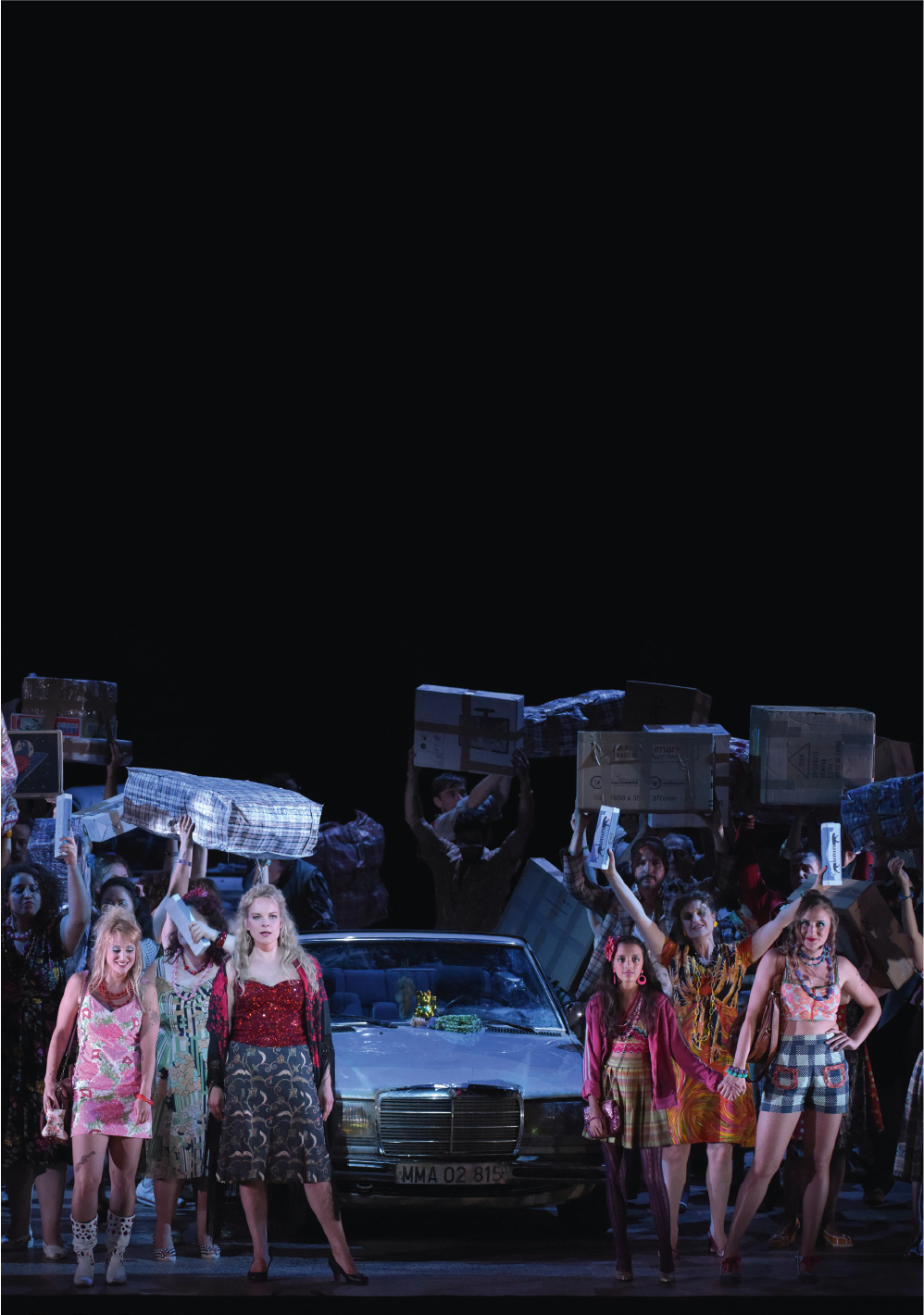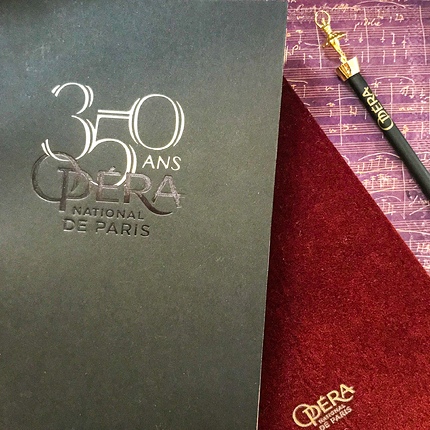Le live-chat a commencé, n'hésitez pas à réagir et à poser vos questions aux artistes !
Flavion : Bonjour les artistes ;-)
Marie : Vous souvenez-vous de votre première rencontre avec Casse-Noisette ?
Marion Barbeau : J'ai dû le voir quand j'étais petite. Mais mon premier vrai souvenir, c'est en tant que danseuse du Corps de Ballet, ce devait être au cours de ma troisième année, lorsque j'ai participé à toutes les danses du Corps de Ballet dans la version de Noureev, qui ne sont pas évidentes. On dit souvent que la version de Rudolf Noureev est féérique, mais elle est assez sombre malgré tout.
Marine Garnio : Pour ma part, mon premier contact avec Casse-Noisette, c'était à Marseille, lorsque j'étais petite, avec la version de Roland Petit. J'en ai conservé très peu de souvenirs. Puis, par la suite, comme Marion, ici, dans le Corps de Ballet. Je n'ai pas eu la chance de tellement participer au ballet parce que j'étais encore trop jeune. J'ai un peu dansé la Valse des fleurs.
Victor : Comment avez-vous réagi en apprenant que vous danseriez le rôle principal de cette nouvelle version de Casse-Noisette mise en scène par Dmitri Tcherniakov ?
Marion Barbeau : On nous avait prévenu que ça n'aurait rien à voir avec le Casse-Noisette qu'on connaissait déjà. J'ai été surprise qu'on me choisisse parce que c'est une très grosse production avec beaucoup de chorégraphes. C'était une super nouvelle !
Marine Ganio : Quand Dmitri Tcherniakov nous a parlé de ce projet, je me suis tout de suite dit que ce rôle était très enrichissant, et que c'était cela qui m'intéressait dans mon évolution personnelle. Je me suis dit que celle qui aurait la chance de faire ce rôle, ce serait super pour elle. Puis il y a eu la première répétition, avec Edouard Lock, et on m'a fait confiance. Ce n'était pas du tout prévu.
Marion Barbeau en répétition © Agathe Poupeney / OnP
Ninagimarium : Bonjour, j'ai pu découvrir Marion Barbeau dans le documentaire Relève et je l'ai toujours trouvée sublime avec Léonore Baulac.
Michèle : Dmitri Tcherniakov a annoncé que sa version de Casse-Noisette n'aurait rien à voir avec les versions que nous connaissons. Pouvez-vous nous en dire plus ?
Maria : Can you tell how Tcherniakov working with choreographers? How are they depended on the idea of the director? Sorry, I do not speaking French.
OperaBT : Casse-Noisette n'est pas plutôt un ballet de Noël que de Pâques ?
Marine Ganio : Je suis persuadée qu'il ne faut pas venir à la soirée dans la perspective de voir Casse-Noisette. C'est très différent. De plus, toute l'histoire découle de Iolanta. Il y a ce lien très fort entre les deux œuvres. Ce n'est pas l'histoire de Casse-Noisette que l'on connaît avec le réveillon de Noël.
Marion Barbeau : L'héroïne ne traverse pas les mêmes expériences, même si cela la fait grandir également, comme dans le Casse-Noisette que l'on connaît. Ce serait le point commun qu'on pourrait trouver.
FreakMcLyric : Cette peur de grandir qu'évoque Marion pour Marie, qui est probablement le reflet de l'inquiétude que ressent Iolanta à l'idée de retrouver la vue, est-elle le fil conducteur de la production de Tcherniakov ?
Marion Barbeau : L'histoire imaginée par Tcherniakov est violente. Plus réelle aussi. Elle va plus loin dans le sens où l'héroïne expérimente des choses plus concrètes dans la vie, des choses pas forcément agréables.
Marine Ganio : Elle traverse des peurs : l'angoisse du vide, de l'immensité, l'angoisse de grandir, de voir le monde extérieur. Des peurs réelles que nous autres, spectateurs, pouvons comprendre.
Marion Barbeau : Cette partie angoissante contraste avec tout le début, ici chorégraphié par Arthur Pita, où elle vit dans un cocon, quelque chose de très chaleureux, elle est très entourée, protégée de l'extérieur pour qu'elle ne soit pas traumatisée par la vie.
S_G : Je souhaitais aussi vous dire que je trouve Marion Barbeau magnifique dans ce rôle. J'ai pu la découvrir a travers ce ballet en tant que figurant. des photos que j'ai vu, Marine Ganio a l'air sublime aussi :)
Thibault : Votre travail de danseuse est-il également un travail d'actrice ?
Marion Barbeau : C'est sûr que c'est la première fois où ça nous demande autant de réflexion sur la manière de jouer, mais sans le danser, sans pantomime. Cela passe par un regard ou des gestes qu'on pourrait faire dans la vie. C'est très moderne. Ce n'est pas surjoué, c'est ressenti. Emotionnellement, c'est très fort. Dans le travaill, on ne se rend pas forcément compte. Au fur et à mesure que le projet se construit et prend forme, quand on rentre dedans, c'est très émouvant. Pas forcément parce qu'on se pose des milliers de questions sur sa vie. On n'a pas le temps. Mais cela crée des choses dans le corps. Rien que la scène des flocons est incroyablement forte dans cette version.
Raphaël : Ce Casse-Noisette a été chorégraphié par trois chorégraphes. Comment ont-ils travaillé ensemble ?
Marion Barbeau : On n'a jamais travaillé avec les trois chorégraphes ensemble. Ils font des parties distinctes. Il y a des transitions, mais ce n'est pas ce qu'on fait en premier. Il y a un travail en amont avant de bâtir la chorégraphie, pour comprendre comment le chorégraphe travaille, apprendre à le connaître et qu'il apprenne à nous connaître. Ce sont trois univers très différents. Arthur Pita, c'est beaucoup de parties jouées. Juste des petites danses qui sont inspirées des années 1950. Mais c'est surtout beaucoup de jeu. Il est très fort pour ça, c'est très clair, c'est très vrai. Il a beaucoup d'humour, on le ressent dans sa partie. C'est à la limite de l'absurde. Edouard Lock travaille de manière très particulière dans le sens où il recourt à de tout petits mouvements très précis. On travaille beaucoup avec la vidéo. On regarde et on apprend. Une fois appris, on peut travailler, et en fonction de ça, il change beaucoup. C'est très intéressant. Il ne veut pas construire tout de suite. Il veut surtout voir comment cela peut rendre sur les danseurs et, à la toute fin seulement, on comprend ce que ça va être. Enfin, Sidi Larbi Cherkaoui avait déjà beaucoup bâti sa chorégraphie. Il était avec ses assistants, il nous l'a montrée. Puis il s'adapte en fonction de nous. Mais il a déjà beaucoup travaillé en amont. On apprend à comprendre les gestes qui lui sont propres.
Marine Ganio : On cherche toujours, ça nous fait toujours plaisir de faire partie d'une création. Le fait de rencontrer un chorégraphe, de partager avec lui. On a la chance d'en avoir trois d'un coup, on profite trois fois plus. Malheureusement pour eux, ils doivent partager leur temps. Ils ont l'habitude d'avoir les danseurs toute la journée pour eux. Là, il faut s'adapter, accepter que ça n'avance pas aussi vite. Je pense que ça les trouble un peu et on peut le comprendre. Ces trois personnes sont d'une gentillesse et d'une humanité incroyables... Je trouve que ce sont de belles rencontres. C'est génial. Arthur Pita, c'est de l'acting pur, de petits détails, des regards. Par la suite, on va pouvoir se servir et piocher dans les informations qu'il nous a données pour d'autres choses. Edouard, je lui dois beaucoup. Rien que pour ça, je suis contente d'être en studio avec lui. Travailler avec lui demande beaucoup de précision. Il a une attente très précise. Du coup, cela nous demande beaucoup d'investissement, de patience, de confiance en lui et en son regard. Sidi Larbi Cherkaoui, c'est un travail fascinant de pas de deux. Il a une manière incroyable d'expliquer la relation du corps de la fille avec celui du garçon, leurs interactions. Il n'y a que des conséquences, chaque pas en amène un autre et s'il n'est pas fait de telle manière, ça ne marchera pas. Il a des assistants incroyables, qui nous aident beaucoup . Les expériences de studio avec ces chorégraphes vont nous servir. Elles nous enrichissent déjà.
Carla : Est-ce une difficulté pour vous que de devoir assimiler pour une même pièce trois styles chorégraphiques différents ?
Marion Barbeau : Oui et non. Si on restait de midi à 19 h avec le même chorégraphe, on aurait le temps de le comprendre, de s'adapter physiquement à son travail. En même temps, trois chorégraphes différents, cela permet de compléter le personnage. Evidemment, comme ce sont trois univers différents, on ne peut pas se servir d'un chorégraphe pour l'autre. Mais psychologiquement, ça apporte beaucoup, ça complète la construction du personnage. Il y a forcément des problèmes techniques. Le travail de l'un va se faire pieds nus et celui d'un autre en chaussettes. Edouard préfère les chaussures à talons. Il faut gérer les transitions parce que le personnage de Marie reste en scène pendant tout le ballet. Ce sont des questions techniques mais qui, pour nous, ont beaucoup d'importance.
Marine Ganio en répétition © Agathe Poupeney / OnP
Nora : Avez-vous aimé travailler avec Dmitri Tcherniakov ?
Marine Ganio : Lors de la première présentation du projet qu'on a eue avec Dmitri, le livret était passionnant, mais surtout, ce qui m'a impressionnée, c'est de voir avec quelle intensité il nous le racontait. Il y mettait tout son coeur, toute son âme. Il jouait le livret, il était dedans, il vivait les choses. C'est incroyable de voir comme il est plongé dedans. Je pense que c'est primordial parce que du coup, on a envie de le suivre. On le voit tellement passionné qu'on a envie de le suivre.
Marion Barbeau : On n'a pas vu tout de suite la cohérence de l'ensemble. A chaque fois que Tcherniakov est avec nous, il met l'accent sur la façon de jouer. A chaque fois qu'il nous montre, pour n'importe quel rôle, c'est très clair. Il se met dans la peau des personnages et c'est fascinant de le voir. Il a des idées très précises, c'est très musical. Il connaît toutes les musiques par coeur. Il faut vraiment lui faire confiance, c'est un génie. Il a tout en tête, c'est très précis. Il laisse faire les chorégraphes, mais il a son idée. Il faut la respecter. On peut lui faire confiance les yeux fermés.
Carlos : Quel a été votre plus grand défi dans ce travail ?
Marine Ganio : Ce que j'aime jouer, c'est le côté sombre, tragique. C'est ce genre d'histoire qui m'émeut. Ce sont les drames qui me font vivre passionnément, les grands ballets dramatiques où l'on pleure à la fin. J'aime pleurer dans la salle, et j'aimerais un jour faire pleurer les gens qui viennent me voir.
Marion Barbeau : En tant qu'artiste, on a envie de pleurer, de tomber amoureuse en scène. Et merci ! Parce qu'on est vraiment servis avec cette production. La mise en scène et les chorégraphies font qu'on n'a pas besoin d'en rajouter. Tout est là pour qu'on soit émus.
Marine Ganio : Il faut faire confiance au livret et aux chorégraphes.
Cécile : Lorsque vous composez un personnage, y mettez-vous beaucoup de vous-même ?
Marine Ganio : Dans le cas de Casse-Noisette, avec cette question du passage à l'âge adulte, je ne sais pas vraiment... Je suis mariée. Je vis avec quelqu'un. La crainte de le perdre, cette conscience de la vieillesse à deux, et peut-être de se retrouver seule. Oui, bien sûr, on se reconnaît dans ces préoccupations. C'est plus dans ces craintes de la vie qui se déroule, de tout ce qui nous entoure, des gens qui nous entourent, de la confiance qu'on peut accorder ou non. Parfois, on fait confiance à des personnes très proches, et on ne sait pas si on peut vraiment compter dessus. C'est davantage cet aspect du spectacle qui me touche que la transition d'enfant à adulte. Je ne l'ai pas sentie dans ma vie. Cela me parle moins que toutes ces peurs que Marie va traverser.
Marion Barbeau : Le fait qu'elle tombe amoureuse, qu'elle soit fascinée, pendant une soirée, tous ces regards, oui, cela m'est arrivé plus d'une fois, même si j'essayais d'être un peu plus discrète... (Rires) Oui, en effet, le passage à l'âge adulte, lorsque l'on se rend compte qu'on n'a plus besoin de nos parents, qu'on peut gérer une situation seule... Cela me touche. Ma famille m'a protégée. C'est exactement le cas de Marie : beaucoup d'amour et de protection par rapport au monde qui l'entoure. Le fait d'avoir travaillé à l'Opéra jeune et d'avoir des responsabilités... Oui, bien sûr, il y a des points communs avec cette histoire...
Kenza : Au sein du Ballet de l'Opéra, vous abordez aussi bien le classique que le contemporain. Qu'est-ce que ce mélange vous apporte ?
Marion Barbeau : Forcément, le fait d'avoir une base classique, c'est un excellent bagage. En revanche, pour cette production, par exemple pour les chorégraphies de Sidi Larbi Cherkaoui, il y a certaines choses qu'il faut oublier parce qu'en classique, on a envie de monter, pas forcément de tout prendre dans le sol, parce que musculairement, c'est un tout autre travail. Cela nous sert, mais il y a certaines choses qui sont complètement différentes du classique. En revanche, ça peut être très intéressant de repenser à ce travail quand on redanse du classique. Ce ne sont pas deux styles détachés.
Marine Ganio : Je ne pense pas qu'il y ait un mur entre classique et contemporain. Toute technique peut aider l'autre. Une fois, Sidi Larbi Cherkaoui parlait d'un transfert du poids du corps et je me suis dit que cela semblait tellement logique, normal et pourtant, j'avais tendance à l'oublier alors que je pouvais m'en servir dans le classique. Je pense qu'on peut se servir de toutes les techniques pour s'améliorer.
Marion Barbeau et Stéphane Bullion © Agathe Poupeney / OnP
Nadia : Vous êtes devenue l’héroïne d’un film de la 3e scène où vous étiez transformée en héroïne de dessin animé par le dessinateur Glen Keane. Pouvez-vous revenir sur cette expérience ?
Marion Barbeau : C'était vraiment un cadeau, cette expérience. Rencontrer Glen Keane, c'était un cadeau parce que c'est un génie. C'est quelqu'un d'une bonté infinie. Cela s'est passé sur deux jours, il avait des idées, mais assez ouvertes. C'était en trois parties, en trois diagonales. Le début, c'est une jeune fille, mais qu'on pourrait comparer à une biche, qui a beaucoup d'espoir, qui s'élève dans la vie. On peut aussi la comparer à Marie dans Casse-Noisette, d'une certaine façon. En images, un ouragan la bouscule, elle se met à terre mais elle arrive à trouver la force d'en revenir et elle en sort grandie. Glen avait en tête quelques mouvements, mais il ne connaissait pas vraiment la danse. On a essayé de se mettre d'accord sur une chorégraphie. Et en même temps que je dansais, il dessinait. Avec une vitesse impressionnante. Parfois je faisais des pauses et prenait la pose pour qu'il me dessine. C'était une expérience sublime. C'est très émouvant aussi de se voir en dessin animé. J'aimerais bien ressembler à cette fille. C'est un rêve de petite fille. Surtout que là, c'est Disney.
« Nephtali » by Glen Keane
OISEAUROCK : cette animation, tout, c'est incroyable, troublant par rapport à la danse, merci
Ce live-chat est maintenant terminé. Sonya Yoncheva, qui devait y participer, n'a malheureusement pas pu nous rejoindre.
Merci à tous d'avoir posé vos questions et suivi cette rencontre.




















































































































